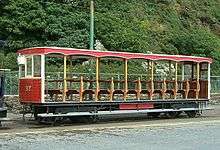Manx Electric Railway rolling stock
This page details the rolling stock on the Manx Electric Railway on the Isle of Man, which is unique insofar as the railway still operates with all of its original tramcars and trailers, all of which are over one hundred years old, the latest dating from 1906. Save for a fire in which several cars and trailers were lost in 1930, all of the line's original rolling stock remains extant though many items have been out of use for a number of years, largely due to the decrease in tourism that the island has experienced over the last thirty years. Despite this, members of each class are still represented in situ today, though not all are in original form or in regular traffic.
Motorcars

Original Cars 1-3 the original trio of tramcars dating from 1893, two of which remarkably remain in regular passenger service today
Tunnel Cars 4-8 known as "tunnel cars" for their elongated appearance and longitudinal seating date from 1894.
Illuminated Car 9 converted into an illuminated car for the line's centenary in 1993, the final of the "tunnel" cars
Cattle Cars 10-13 unpopular and not in service for long, being converted to goods trams 1904-06. Only one of these cars now remains, in rebuilt form as a cattle car
Toastracks 14-18 the first set of open toastracks dating from 1898, all of which have survived and are still extant
Winter Saloons 19-22 these cars date from 1899 and form the mainstay of the service fleet today, with all four in operation
Paddleboxes 24-27 the "paddlebox" cars are so-called due to their unusual footboards that are built to accommodate protruding bogies
Toastracks 29-31 a further batch of three open toastracks supplied to the railway, capable of hauling two full trailers
Toastracks 32-33 the final batch of cars and the most powerful supplied to the railway, capable of hauling two full trailers
Trailers

Lightweight Trailers 36-39 these trailers were the first supplied to the railway for the 1893 opening
Bulkhead Trailers 40-41 two 1930-built cars, in replacement for those lost in a disastrous fire at the car sheds
Toastrack Trailers 42-44 these three trailers all remain in service, commonly in use with the winter saloons
Bulkhead 45-48 a batch of four crossbench trailers from 1898, one of which is now a flatbeg wagon
Lightweight Trailers 49-54 only one of these trailers remains in regular service having been restored to near original condition
Disabled Trailer 55-56 one of which was converted to form the railway's first and only disabled access trailer
Winter Trailers 57-58 the line's only two enclosed or "winter" trailers, used latterly on the "steam on the electric" events
Royal Trailer 59 the royal saloon, now mounted on bogies was originally a four-wheel carriage
Toastrack Trailer 60 a one-off order from 1896, usually paired off with ratchet car 16 which carries the same livery
Toastrack Trailers 61-62 the last two trailers, delivered with and used in service by the final motor cars, 32 and 33 more recently
Others

- Car 34
- originally built as Maria for the Snaefell Mountain Railway in 1995, this is a replica of an original 1895 car, which was used for hauling coal up to the generating station above Laxey.
- Locomotive 23
- built for the Dhoon stone traffic as a conventional steeple cab locomotive. Damaged in a derailment in 1914, but not immediately withdrawn. Cab and control gear from the original locomotive being used to produce the present version in 1926. Something of an oddity, consisting of a steeple cab between two three plank drop side freight compartments. The railway's only electric locomotive, currently in store and privately owned.
- Bertie
- a contractors' locomotive used when relays were being undertaken and subsequently purchased for permanent way use.
- Bungle
- purchased second-hand from Bord na Móna in 2008 and refurbished on-island for further use on the railway.
- Zippy
- purchased second-hand from Bord na Móna in 2008 and refurbished on-island for further permanent way use on the railway.
- Bonner Wagons
- road-rail dual purpose wagons dating from the earliest days of the line, none of which are extant today.
- Aachen 1010
- bought for use but never converted, spending much of its life as a storage car at the railway's depot.
.jpg)
- Lisbon car (former CCFL 360)
- a Stephenson-built 1907 bogie car in that city’s unusual track gauge of 900 mm (2 ft 11 7⁄16 in), bought for conversion to Manx Electric Railway’s almost identical 3 ft (914 mm) gauge, — conversion never implemented due to clearance difficulties; vehicle now in off-site storage on the island.
- Dreadnought Trailers
- bogie open wagons with removable sides used for a variety of non-passenger purposes, but particularly associated with stone traffic from Dhoon Quarry, now all scrapped. General 12 ton capacity bogie vehicles.
- Four Wheel Goods Vehicles
- from 1894 onwards the Douglas and Laxey Electric Tramway and its successors operated a fleet of small four wheel goods wagons, mainly of 5 ton, and 6 ton capacity. There were a total of ten opens and eight vans built by Milnes, Milnes Voss, and the MERCo between 1894 and 1912. Some of the vans were painted red and used for mail traffic.
See also
References
- Mike Goodwyn (1993). Manx Electric. Platform Five. ISBN 978-1-872524-52-8.
- Keith Pearson (1992). 100 Years Of Manx Electric Railway. Leading Edge. ISBN 0-948135-38-7.
- Robert Hendry (1978). Manx Electric Album. Hillside Publishing. ISBN 0-9505933-0-3.
- Norman Jones (1994). Isle Of Man Tramways. Foxline Publishing. ISBN 1-870119-32-0.
Sources
- Manx Manx Electric Railway Fleetlist (2002) Manx Electric Railway Society
- Island Island Images: Manx Electric Railway Pages (2003) Jon Wornham
- Official Tourist Department Page (2009) Isle Of Man Heritage Railways